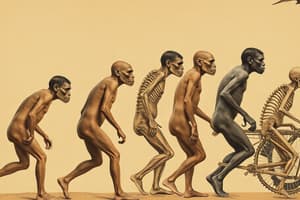Podcast
Questions and Answers
What time range do australopiths primarily span?
What time range do australopiths primarily span?
- ~ 6 Ma to ~ 2 Ma
- ~ 5 Ma to ~ 3 Ma
- ~ 7 Ma to ~ 4 Ma
- ~ 4 Ma to ~ 1 Ma (correct)
Which of the following is a defining feature of australopiths?
Which of the following is a defining feature of australopiths?
- Strictly arboreal lifestyle
- Bipedalism with some tree usage (correct)
- Possession of complex tools
- Large brain size
What are the two main genera of Australopiths?
What are the two main genera of Australopiths?
- Homo and Paranthropus
- Australopithecus and Paranthropus (correct)
- Kenyanthropus and Australopithecus
- Australopithecus and Homo
Where were the earliest australopith fossils first discovered?
Where were the earliest australopith fossils first discovered?
Which species is known as the best-known australopith?
Which species is known as the best-known australopith?
What is a significant derived trait of Australopithecus anamensis?
What is a significant derived trait of Australopithecus anamensis?
Which habitat did Australopithecus afarensis NOT likely inhabit?
Which habitat did Australopithecus afarensis NOT likely inhabit?
What is the significance of the AL 288-1 specimen of Australopithecus afarensis?
What is the significance of the AL 288-1 specimen of Australopithecus afarensis?
Which of the following features indicates habitual bipedalism in Australopithecus afarensis?
Which of the following features indicates habitual bipedalism in Australopithecus afarensis?
Australopithecus anamensis exhibits primitive traits. Which of the following is considered a primitive trait?
Australopithecus anamensis exhibits primitive traits. Which of the following is considered a primitive trait?
Which factor contributed to the locomotion adaptations seen in Australopithecus afarensis?
Which factor contributed to the locomotion adaptations seen in Australopithecus afarensis?
What does the presence of diastema in Australopithecus afarensis suggest?
What does the presence of diastema in Australopithecus afarensis suggest?
Which of the following statements about Australopithecus afarensis is incorrect?
Which of the following statements about Australopithecus afarensis is incorrect?
What function does the valgus knee serve in bipedal adaptations?
What function does the valgus knee serve in bipedal adaptations?
Which adaptation in the foot contributes to bipedal efficiency?
Which adaptation in the foot contributes to bipedal efficiency?
Which feature of Australopithecus afarensis indicates its bipedalism?
Which feature of Australopithecus afarensis indicates its bipedalism?
What is a notable characteristic of the dentition in Australopithecus africanus compared to Australopithecus afarensis?
What is a notable characteristic of the dentition in Australopithecus africanus compared to Australopithecus afarensis?
What did the Laetoli footprints reveal about Australopithecus afarensis?
What did the Laetoli footprints reveal about Australopithecus afarensis?
What does the finding of Australopithecus garhi suggest about the species' behavioral traits?
What does the finding of Australopithecus garhi suggest about the species' behavioral traits?
What does the anatomical structure of the foot with a longitudinal arch provide?
What does the anatomical structure of the foot with a longitudinal arch provide?
Which Australopithecus species is considered a potential ancestor to the genus Homo?
Which Australopithecus species is considered a potential ancestor to the genus Homo?
What does the term 'robust' in Robust Australopithecines refer to?
What does the term 'robust' in Robust Australopithecines refer to?
What is the significance of long femoral necks in hominins?
What is the significance of long femoral necks in hominins?
What primitive characteristic is still retained in some bipedal hominins?
What primitive characteristic is still retained in some bipedal hominins?
Where was Australopithecus aethiopicus primarily found?
Where was Australopithecus aethiopicus primarily found?
What is a key difference between Taung Baby and Selam in terms of growth patterns?
What is a key difference between Taung Baby and Selam in terms of growth patterns?
What evidence suggests the bipedalism of A. afarensis was not as efficient as modern humans?
What evidence suggests the bipedalism of A. afarensis was not as efficient as modern humans?
What is the approximate age range for Australopithecus sediba?
What is the approximate age range for Australopithecus sediba?
What adaptation is suggested for Australopithecus africanus based on its cranial and dental characteristics?
What adaptation is suggested for Australopithecus africanus based on its cranial and dental characteristics?
What dietary adaptations are observed in Australopithecus afarensis?
What dietary adaptations are observed in Australopithecus afarensis?
Which of the following statements about australopith diets is true?
Which of the following statements about australopith diets is true?
What is true about sexual dimorphism in australopiths?
What is true about sexual dimorphism in australopiths?
Which australopith species is considered to possibly lead to the genus Homo?
Which australopith species is considered to possibly lead to the genus Homo?
Which feature is MOST characteristic of Paranthropus species?
Which feature is MOST characteristic of Paranthropus species?
Which of the following is NOT a determining factor in species relationships among early hominins?
Which of the following is NOT a determining factor in species relationships among early hominins?
Which of these australopith species lived approximately 2 million years ago?
Which of these australopith species lived approximately 2 million years ago?
Which anatomical adaptation suggests a diet of hard or tough foods in australopiths?
Which anatomical adaptation suggests a diet of hard or tough foods in australopiths?
Flashcards
What are Australopiths?
What are Australopiths?
A group of extinct hominins that lived from about 4 million to 1 million years ago. They are known for their bipedal locomotion but also their adaptations for arboreal living, and their diverse dietary adaptations.
How are Australopiths classified?
How are Australopiths classified?
Two genera of Australopiths: Australopithecus and Paranthropus. They are distinguished based on their physical characteristics and adaptations.
Where were the Australopiths found?
Where were the Australopiths found?
They lived in both East Africa (where the oldest sites are found) and South Africa.
What is Australopithecus afarensis?
What is Australopithecus afarensis?
Signup and view all the flashcards
What is Kenyanthropus platyops?
What is Kenyanthropus platyops?
Signup and view all the flashcards
Australopithecus afarensis
Australopithecus afarensis
Signup and view all the flashcards
Paranthropus
Paranthropus
Signup and view all the flashcards
Sexual dimorphism
Sexual dimorphism
Signup and view all the flashcards
Post-canine dentition
Post-canine dentition
Signup and view all the flashcards
Clade
Clade
Signup and view all the flashcards
Phylogeny
Phylogeny
Signup and view all the flashcards
Homo
Homo
Signup and view all the flashcards
Australopithecus
Australopithecus
Signup and view all the flashcards
Valgus knee
Valgus knee
Signup and view all the flashcards
Enlarged heel
Enlarged heel
Signup and view all the flashcards
Longitudinal arch
Longitudinal arch
Signup and view all the flashcards
Big toe in line with other toes
Big toe in line with other toes
Signup and view all the flashcards
Arboreal retentions
Arboreal retentions
Signup and view all the flashcards
A. afarensis bipedalism
A. afarensis bipedalism
Signup and view all the flashcards
Laetoli Footprints
Laetoli Footprints
Signup and view all the flashcards
Laetoli Tracks and modern analysis
Laetoli Tracks and modern analysis
Signup and view all the flashcards
Bipedal Adaptations - Hip
Bipedal Adaptations - Hip
Signup and view all the flashcards
Ilium, Pelvis
Ilium, Pelvis
Signup and view all the flashcards
Sacrum-Ilium Joint
Sacrum-Ilium Joint
Signup and view all the flashcards
Diastema on Mandible
Diastema on Mandible
Signup and view all the flashcards
Small Canines, Thick Enamel, & Large Molars
Small Canines, Thick Enamel, & Large Molars
Signup and view all the flashcards
Ape-like Brain Size
Ape-like Brain Size
Signup and view all the flashcards
Australopithecus africanus
Australopithecus africanus
Signup and view all the flashcards
Australopithecus garhi
Australopithecus garhi
Signup and view all the flashcards
Australopithecus sediba
Australopithecus sediba
Signup and view all the flashcards
Paranthropus (Robust Australopithecines)
Paranthropus (Robust Australopithecines)
Signup and view all the flashcards
Paranthropus aethiopicus
Paranthropus aethiopicus
Signup and view all the flashcards
Paranthropus boisei
Paranthropus boisei
Signup and view all the flashcards
Paranthropus robustus
Paranthropus robustus
Signup and view all the flashcards
Foramen Magnum Position
Foramen Magnum Position
Signup and view all the flashcards
Study Notes
Australopithecines
- Australopithecines are a group of extinct hominins that lived between approximately 4 million and 1 million years ago.
- The species are traditionally grouped into two genera: Australopithecus and Paranthropus.
- Fossil evidence suggests a range of variation in traits and adaptations, leading to significant diversity within the group.
- The geographic distribution encompasses sites in East and South Africa.
- Many different species existed during this period creating the complex evolution of species.
- Important specimens like "Lucy" (AL 288-1) provide crucial insights into locomotion, morphology, and life history patterns.
Australopithecus anamensis
- This species, from Kenya/Ethiopia, lived 4.2-3.8 million years ago, making it one of the oldest australopithecines.
- Derived traits include smaller canines, thicker enamel, and larger molars.
- Evidence of bipedalism is suggested by features of the knee and ankle.
- Primitive traits, such as a box-shaped jaw, indicate a possible link to earlier hominins.
- This species likely moved between grasslands and woodlands.
Australopithecus afarensis
- A. afarensis, well-known from sites in East Africa (3.7-2.9 million years ago), lived in diverse habitats (forests, woodlands, and savannah).
- Important specimens include "Lucy" (AL 288-1), revealing details about locomotion.
- Other specimens, like AL 333 (the "First Family") and the Selam child, offer insights into their anatomy and likely behavior.
- Footprints at Laetoli (Tanzania, 3.6 million years ago) further support the interpretation of habitual bipedalism.
- A. afarensis possessed a mixture of primitive and derived traits, placing it as an intermediate form.
- Physical features, such as a relatively ape-like skull and body, but with more upright walking posture, illustrate an adaption to a specific environment and lifestyle.
Australopithecus africanus
- A. africanus is found in South Africa (3-2.2 million years ago).
- The "Taung baby" (first discovery in 1924) is a significant specimen of this species.
- Features include a foramen magnum position suggesting bipedalism, but this was initially debated by scientific community
- Postcrania is similar to A. afarensis, but the dentition distinguishes A. africanus, with smaller canines and incisors but larger molars.
- Cranium and body structure resemble A. afarensis but have larger cheek teeth and a deeper mandible, suggesting significant dietary adaptations.
Australopithecus garhi
- Found in Afar, Ethiopia (2.5 million years ago).
- Larger molars and premolars compared to A. africanus.
- Associated with cut-marked animal bones, suggesting butchery potentially implying meat consumption and hinting at a diet shift.
- Stone tools found in similar deposits adds to evidence of meat consumption and tool use.
Australopithecus sediba
- A recent (2010) discovery in South Africa (2-1.8 million years ago).
- Features a combination of primitive and derived traits, which led to the question of whether this might be a transitional species in human lineage.
- Possessed a small brain, yet a Homo-like face.
- Two partial skeletons of this species have been found highlighting a clear bipedalism but also retaining some features, like long arms that would allow living in a mixed environment.
Paranthropus
- The "robust" australopithecines, Paranthropus, are a separate lineage from early hominins that diverged sometime between 4-1 million years ago.
Paranthropus aethiopicus
- Found in Lake Turkana, Kenya (2.5 million years ago).
Paranthropus boisei
- Found in East Africa (2.2-1.3 million years ago). Commonly found in conjunction with fossils of Homo habilis.
Paranthropus robustus
- Found in South Africa (2-1 million years ago). This species is often found in association with remains from A. africanus.
Bipedalism Adaptations
- Pelvis: Ilium flared and rotated allowing for hip abductors to keep body over midline, enlarged sacrum-ilium joint for load bearing,
- Femur & Knee: Valgus knee with femurs angled medially to center body mass. This reduces the side to side motion when walking.
- Foot: Enlarged heel to absorb impact at heel strike, longitudinal arch for propulsive lever and shock absorption, and big toe in line with the other toes.
Arboreal Adaptations
- Relatively long arms, mobile shoulder joints, and curved fingers & toes.
- Suggests substantial adaptations of the skeletal system to spend time in trees for protection.
Sexual Dimorphism
- Body size dimorphism: significant differences in size between males and females, similar to modern gorillas and orangutans.
- Canine dimorphism: less noticeable canine differences compared to chimpanzees, but more than in humans.
- These combined characteristics present a unique blend.
Early Hominin Phylogeny
- Uncertain relationships and evolutionary pathways of Early hominins.
- Many gaps and unanswered questions regarding the evolutionary lineage of certain hominins to the genus Homo.
- Probable separation of australopithecus from other lineages. This division included modern, and extinct human species as well as those now extinct human ancestors with whom they shared anatomical similarities.
Studying That Suits You
Use AI to generate personalized quizzes and flashcards to suit your learning preferences.





